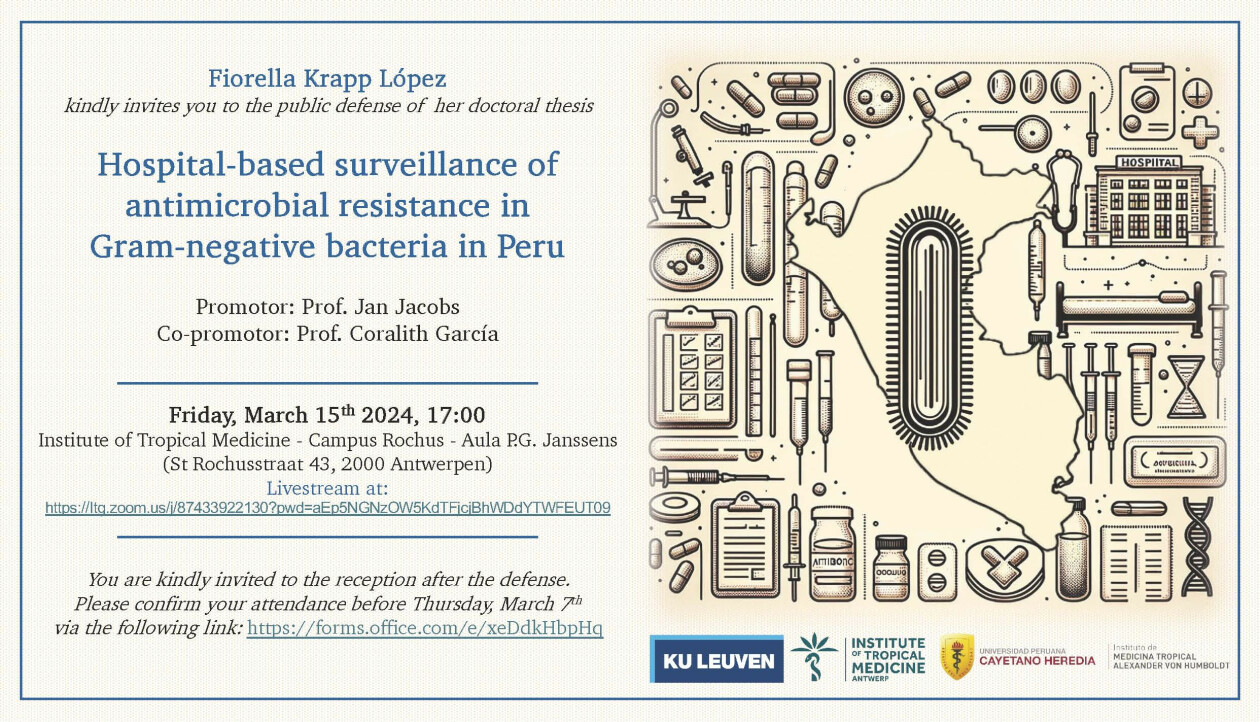PhD defence Fiorella Krapp-López

Supervisors
Prof. dr. Jan Jacobs (ITM/KU Leuven)
Prof. dr. Coralith Garcia (Instituto de Medicina Tropical Alexander von Humboldt, Universidad Peruana Cayetano Heredia, Peru)
Abstract
The global emergence of antimicrobial resistance (AMR) is a critical threat to human health. The rapid emergence of resistance to last-resort antibiotics among Gram-negative bacteria (GNB) is of special concern, placing these microorganisms as critical priority for surveillance, research, and development of new antibiotics. Low- and middle-income countries (LMICs) are most impacted by AMR, with higher ratios of AMR and higher burden of disease. However, critical gaps in AMR surveillance have been reported in these countries. This thesis focused on characterizing different aspects of AMR in Gram-negative bacteria in Peru, an upper-middle-income country, through a multi-layer hospital-based surveillance, with each Chapter corresponding to a different layer of surveillance.
We conducted multicenter studies at 15 hospitals of Peru to assess the quality and utilization of blood culture for diagnosis of bloodstream infection among hospitalized patients in Peru. We found that underutilization of blood culture testing is a common practice among treating physicians at tertiary public hospitals in Peru. We also found that more than two thirds of the assessed hospitals had a contamination rate above the recommended target and more than 90% of the processed bottles were underfilled. This highlights the need to optimize the utilization blood culture as a diagnostic tool and the quality of blood culture processing in public hospitals in Peru, to improve patient management and support national initiatives to establish antibiotic stewardship hospital programmes and strengthen antimicrobial resistance surveillance.
We also conducted a hospital-based surveillance study in 15 hospitals across Peru. From July 2017 to October 2019, we collected consecutive isolates of four key GNB (199 Escherichia coli, 118 Klebsiella pneumoniae, 81 Pseudomonas aeruginosa and 51 Acinetobacter spp.) recovered at the hospital microbiology laboratory from routine processing of blood cultures from hospitalized patients, along with clinical and epidemiological data from the source patients. We found that antimicrobial resistance in Gram-negative bacteria is an important problem in Peru, with a high prevalence in bloodstream infections (81.3% of the isolates presented resistance to at least one antibiotic and 69.0% were MDR). We also found that administration of inactive empiric treatment is are frequent among these infections, with more than one third of the patients receiving inactive empiric treatment. Resistance to third-generation cephalosporins and resistance to carbapenems increased the risk of receiving inactive empiric treatment. The all-cause in-hospital mortality was 33% and having a bloodstream infection caused by P. aeruginosa or a carbapenem-resistant GNB increased the risk of death. These results highlight the need to develop local guidelines to manage these infections and the urgent need to contain antimicrobial resistance in Peru.
Finally, we conducted whole genome sequencing of 66 carbapenem-resistant Klebsiella pneumoniae (CRKP) isolates recovered during five years after the first case of CRKP was identified at a tertiary hospital in Lima, Peru. We found that the emergence of CRKP at this hospital was multiclonal, driven initially by multiple Klebsiella subspecies carrying the blaKPC-2 gene and later displaced by K. pneumoniae sensu stricto clones carrying the blaNDM-1 gene. Furthermore, the blaNDM-1 gene was mostly harbored in a Tn125-like transposon very similar with previously reported CRKP sequences from two other hospitals in Lima. In addition, we demonstrated that Peru has a predominance of ST11, ST147, ST45 and ST348 lineages (the last two appear to be potential high-risk clones bred in Peru) carrying blaNDM carbapenemase genes in contrast with the predominance of ST258/512 and ST11 sequences carrying blaKPC carbapenemase genes in many other countries of South America. The emergence of NDM-producing carbapenem resistant Klebsiella pneumoniae in Peru constitutes a major threat given the limited therapeutic options available against this pathogen. To contain this threat, it is critical that infection prevention and control measures are strengthen at Peruvian hospitals.
Schedule
Defence: 5-7 pm
Reception: 7.15-8.30 pm, Karibu, ITM
Online link: https://itg.zoom.us/j/87433922130?pwd=aEp5NGNzOW5KdTFjcjBhWDdYTWFEUT09
Please confirm your attendance on-site (with reception) or virtually before March 7th via the following link: https://forms.office.com/e/xeDdkHbpHq

Faites passer le mot ! Partagez cet événement sur